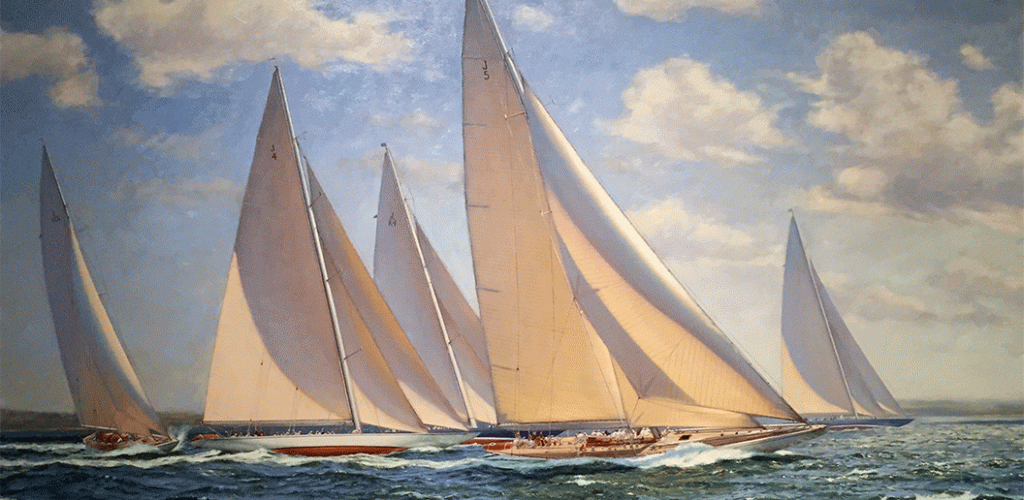The America’s Cup, the pinnacle of yachting, was first contested in 1851 making it the oldest trophy in international sport, predating the modern Olympic Games by 45 years.
The trophy’s roots date back to when a syndicate of businessmen from New York sailed the schooner America across the Atlantic Ocean for the World’s Fair in England. The schooner won a race around the Isle of Wight against a fleet of British yachts to claim the £100 Cup.
From there, the United States embarked on what would become the longest winning streak in the history of sport. A 132-year stretch saw boats representing the country successfully defend the trophy 24 times from 1870 through 1980—until 1983, when Australia II became the first successful challenger to lift the trophy from the Americans.
Throughout its history, the America’s Cup has enchanted leaders of industry and royalty from tea merchant Sir Thomas Lipton, to brewing and real estate mogul Alan Bond, aviation pioneer Sir T.O.M. Sopwith, the Aga Khan, media mogul Ted Turner, and Harold S. Vanderbilt. Not to mention the icons of the sport of sailing such as Tom Blackaller, Peter Blake, Dennis Conner and Russell Coutts and Grant Dalton.
The Legacy Begins – ‘Your Majesty, there is no second’
In 1851 a radical looking schooner ghosted out of the afternoon mist and swiftly sailed past the Royal Yacht stationed in the Solent, between the Isle of Wight and the south coast of England, on an afternoon when Queen Victoria was watching a sailing race.
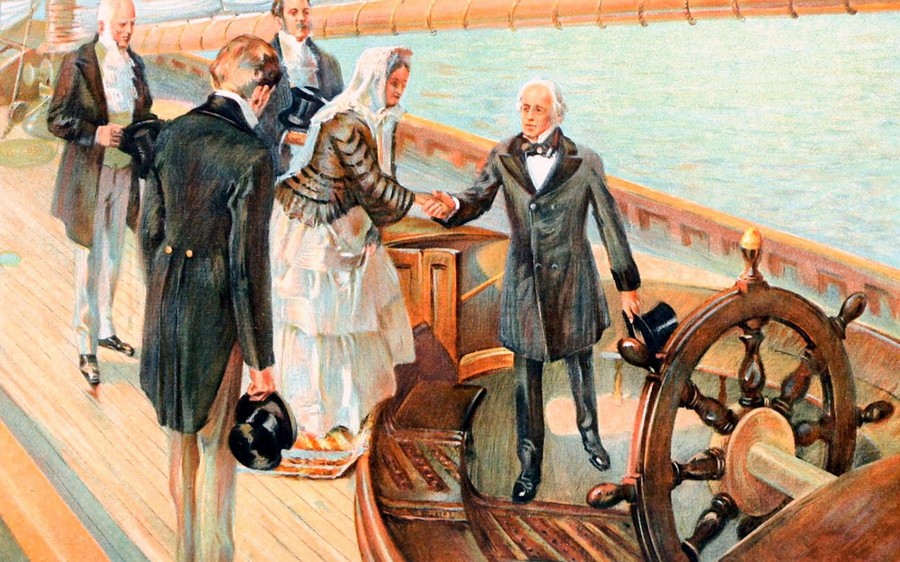
As the schooner, named America, passed the Royal Yacht in first position, and saluted by dipping its ensign three times, Queen Victoria asked one of her attendants to tell her who was in second place.”Your Majesty, there is no second,” came the reply. That phrase, just four words, is still the best description of the America’s Cup, and how it represents the singular pursuit of excellence.
That day in August, 1851, the yacht America, representing the young New York Yacht Club, would go on to beat the best the British could offer and win the Royal Yacht Squadron’s 100 Pound Cup. This was more than a simple boat race however, as it symbolised a great victory for the new world over the old, a triumph that unseated Great Britain as the world’s undisputed maritime power.
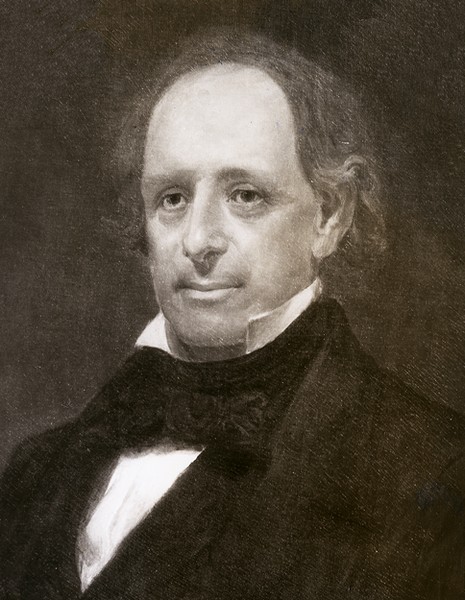
The trophy would go to the young democracy of the United States and it would be well over 100 years before it was taken away from New York.
Shortly after America won the 100 Guinea Cup in 1851, New York Yacht Club Commodore John Cox Stevens and the rest of his ownership syndicate sold the celebrated schooner and returned home to New York as heroes. They donated the trophy to the New York Yacht Club under a Deed of Gift, which stated that the trophy was to be “a perpetual challenge cup for friendly competition between nations.”
Thus was born the America’s Cup, named after the winning schooner America.
The America’s Cup is without a doubt the most difficult trophy in sport to win. In the more than 160 years since that first race off England, only four nations have won what is often called the “oldest trophy in international sport.” For some perspective, consider that there had been nine contests for the America’s Cup before the first modern Olympic Games were held in Athens in 1896.
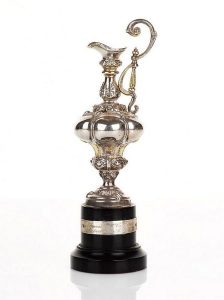
Early Challenges
The very first challenge would come from Englishman James Ashbury, who raced against a fleet from the New York Yacht Club just off Staten Island in 1870. After much dispute over the conditions for racing, Ashbury’s Cambria finished tenth in the 17 boat fleet, prompting a second challenge the following year.
The 1871 America’s Cup match was a precursor for many of the legal battles that would engulf the Cup over the next 100 years. After reportedly consulting his lawyers, Ashbury insisted on racing against just one boat, not an entire fleet and protested both the scoring of the races and the Race Committee who set the race course. In the end he limped home complaining bitterly about poor sportsmanship on the part of the Americans and insisting he had actually won the America’s Cup, to no avail.
The next two Challenges came from Canada, but the northerners were no match for the Americans and were soundly beaten.
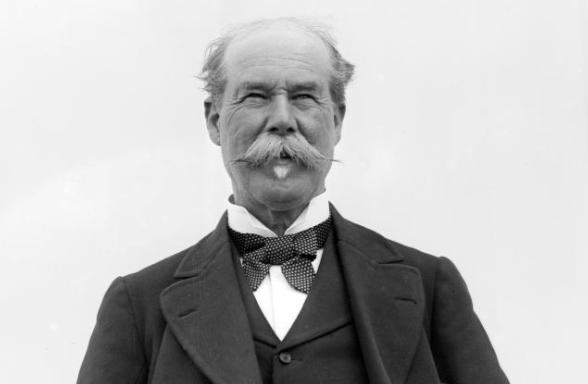
The Lipton Era
There were a further six challenges before the turn of the Century, including the first of what came to be called the Lipton era of the America’s Cup. Sir Thomas Lipton, the Irish/Scottish tea baron challenged five times between 1899 and 1930. He became the loveable loser; a man whose good-natured approach to the obstacles stacked against him turned him into a folk hero and promoted his business interests in America as well.
While Lipton didn’t win the America’s Cup, he became one of the first to introduce the idea of sports sponsorship, and he realised a financial windfall from it. Lipton’s final challenge in 1930 was the first in the new J-Class boats. This was a period of magnificent beauty afloat, as the towering masts carrying an improbable amount of sail powered through the chop off Newport, Rhode Island. Harold Vanderbilt was selected to defend for the New York Yacht Club that year and did so with ease.
Post War
The Second World War marked the end of the J-Class, and when America’s Cup racing began again in 1958, it signaled the beginning of the 12-Metre era. The Americans would successfully defend eight more times over the next 25-year period. Sadly, in 1939, all but three of the original ten J’s were used as scrap metal for the war effort. The three surviving J-Class yachts have been restored and still sail in regattas around the world.
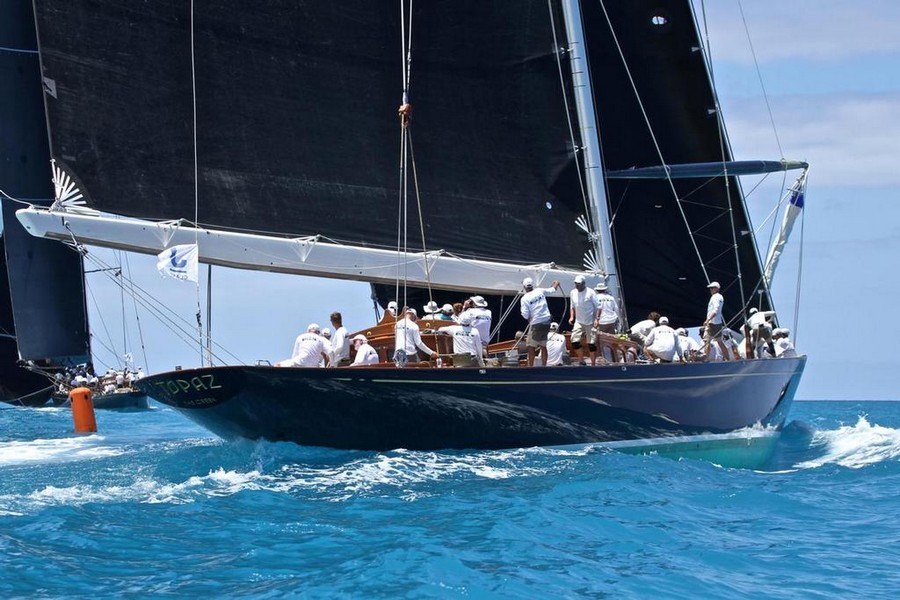
Challenger Series
In 1970, there waS more than one yacht club interested in challenging for the America’s Cup, so for the first time, a competition was staged to determine the single Challenger that would face the Defender, the New York Yacht Club.
The French malletier Louis Vuitton became involved with the America’s Cup in 1983, supporting the Challenger Selection Series that came to be known as the Louis Vuitton Cup. The idea was twofold; to develop and identify the strongest possible challenger for the America’s Cup and ensure that they were sufficiently battle-tested through tough competition to beat the Defender.
The defenders had been involved in this type of selection series for most of the century, but until recently, there had been but one Challenger.
The Cup Leaves America
Australia was one of the challenging countries in 1983, and the ‘Men from Down Under’ brought a secret weapon. Australia II sported a boxing Kangaroo flag in the rigging as she was towed out to sea, and under the water, a radically-designed winged keel that gave the 12-Metre Class boat superior speed under most conditions. The Australians kept the secret to themselves, draping large ‘modesty skirts’ from the deck to the ground when the boat was hauled from the water – keeping prying eyes away and all the time building speculation as to what could be under there.

Dennis Conner, ‘Mr. America’s Cup’, was charged with defending against the upstart Australians, who handily whipped through the challenger fleet and carried off the first Louis Vuitton Cup. That summer, in 1983, the America’s Cup had pride of place on every newscast, and front-page status in every paper. There was a sense of history about that season; that somehow, finally, the New York Yacht Club’s 132-year winning streak was going to come to an end. Equipment problems on the Australian boat allowed Conner to jump ahead early in the best of seven series, but Australian skipper John Bertrand battled back, eventually bringing the series to a score line of 3-3.
The seventh and final race was symbolic of the entire series, with Conner’s Liberty leading for most of the course in a light and shifty breeze. It was not until the final spinnaker run that Australia II was able to jump into the lead, and then hold on to it despite a ferocious, last-gasp assault over the last few minutes. For the first time in 132 years, the America’s Cup was leaving the New York Yacht Club.
Conner, then representing the San Diego Yacht Club, won the right to fight another day in 1987. Held in Fremantle, he won the Louis Vuitton Cup to become the Challenger and then delivered a shut-out victory of 4-0. This America’s Cup featured quite an on-the-water show, with the famous “Fremantle Doctor,” strong afternoon sea-breezes, blowing up incredible sailing conditions with giant white-capped seas, to challenge both the sailors and equipment.
The Return to America
Dennis Conner, basking in presidential welcomes and ticker-tape parades through New York, was in no rush to settle the details of the next event, and New Zealand, exploiting a loophole in the century old Deed of Gift, demanded an immediate challenge in 1988.
What resulted was the first America’s Cup Finals where two different styles of boat raced each other, with the Kiwis in a giant 90-foot waterline boat against Conner in a much smaller but faster hard-winged catamaran. The best of three series went to the Americans and after numerous court challenges – the teams spent far more time battling in a courtroom than they did on the water – the result stood.
America’s Cup Class
A good thing to come of the entire 1988 fiasco was a new class of boat that featured a more modern design that could perform well in the lighter winds of San Diego; the America’s Cup Class, a type of boat built to a design rule.
Under the rule, all boats must look similar, although the designers had enough leeway to make an impact on boat speed. Progress is always made from one generation to the next.
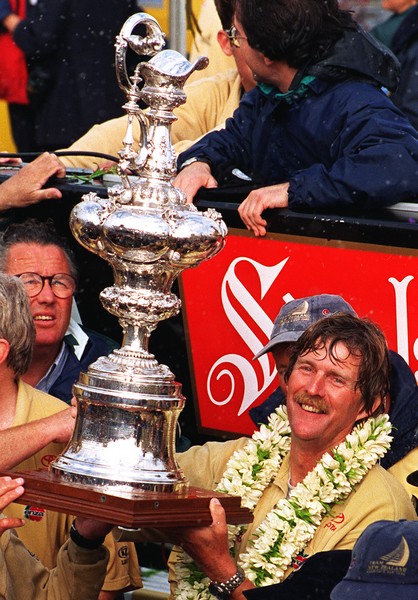
Black Magic
1995 would be the year of the Kiwi. Led by the fierce determination of Sir Peter Blake and with the steady hand of Russell Coutts on the wheel, New Zealand’s Black Magic dominated the challengers in San Diego, and went on to make short work of the Dennis Conner / Paul Cayard defense partnership, taking the America’s Cup back to the Southern Hemisphere.
Sir Peter Blake’s crew declared there would be no defender selection series, and Team New Zealand focused on in-house training, taking advantage of a deep pool of young talent to push Coutts to the limit in training.
In 1992, two American teams sought the right to defend the United States through a Defender series, where Dennis Conner was beaten and lost the right to defend to American billionaire Bill Koch with his massive, four-boat America 3 programme. On the challenger side, New Zealand met the Italian Il Moro de Venezia Challenge, eventually yielding to relentless pressure from the Italians and their skipper Paul Cayard. In the concluding battle for the 29th America’s Cup, Koch, occasionally steering the boat himself, and his skipper Buddy Melges, successfully defended the America’s Cup.
At the same time, the Louis Vuitton Cup in 2000 featured what has been described as perhaps the best two weeks of racing in the history of the America’s Cup. Italy’s Luna Rossa Challenge outlasted Paul Cayard’s AmericaOne, winning the best of nine series 5-4. Not only was the series close, but many of the races were sailed with the boats just metres apart, the lead changing hands over and over again.
But Prada’s Luna Rossa, although battle-hardened, was no match for Team New Zealand. Skipper Russell Coutts staked the Kiwis to a quick 4-0 lead – equaling the record for most consecutive America’s Cup wins set by Charlie Barr 100 years earlier – before handing the wheel to understudy Dean Barker who promptly became the youngest skipper at 26-years old to win the America’s Cup. Team New Zealand looked to be so far ahead of the challengers that the America’s Cup appeared to be secure in the Royal New Zealand Yacht Squadron for a long time to come.
But shortly after the win, Russell Coutts and many of his Team New Zealand stalwarts announced they were defecting to join a new team that had to be built from the ground up for Swiss bio-tech entrepreneur Ernesto Bertarelli.
Within months, in a scene reminiscent of an earlier era, many of the world’s most successful men announced they were coming to stake their claim on the Cup. Backed by Patrizio Bertelli of Prada, the Italians would be back, as would three strong American challenges, including teams backed by Oracle software guru Larry Ellison, and a Pacific Northwest team led by Craig McCaw and Paul Allen. Joining them were teams from France, Italy, Sweden, and for the first time in 16 years, Great Britain, making another run at regaining that which they lost 151 years earlier.
After four months of round robin and elimination rounds, the Louis Vuitton Cup Challenger Series came down to a nine-race final between Ernesto Bertarelli’s Team Alinghi and Larry Ellison’s BMW ORACLE Racing. Both teams arrived at the finals with impressive records in the previous rounds, and the racing showed these two teams were evenly matched. Although the record was a 5-1 series win for Alinghi, the numbers belied how close the racing actually was.
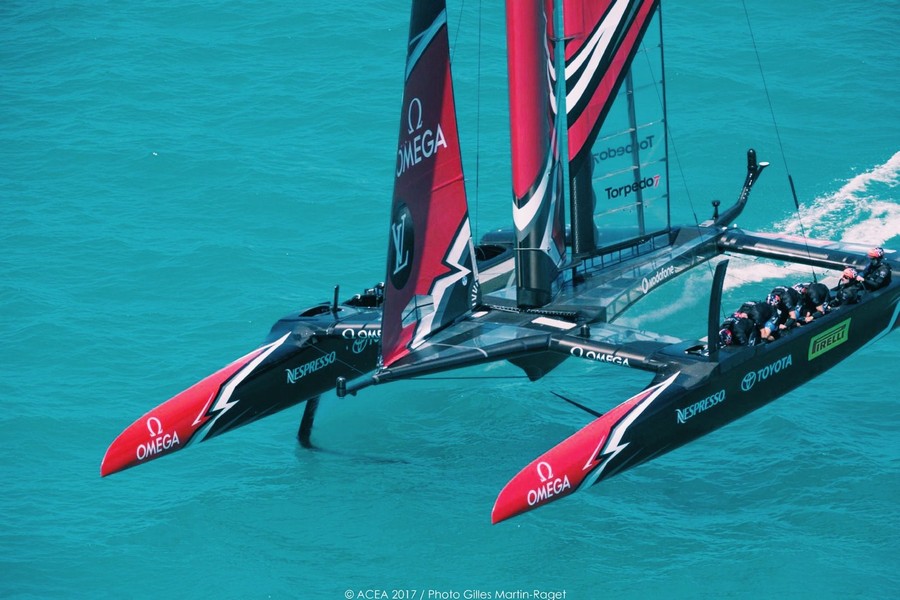
The battle to the win the Louis Vuitton Cup created a very strong Challenger, and set up a much-anticipated America’s Cup Match between Coutts and his old Team New Zealand understudy Dean Barker. Unfortunately for the Kiwis, Team New Zealand was no match for Alinghi who sweep the Match 5-0, and take the America’s Cup to Europe for the first time.
A New Protocol
Shortly after winning the America’s Cup, the Société Nautique de Genève (SNG) accepted a challenge from the Golden Gate Yacht Club, putting the wheels in motion for the 32nd America’s Cup. A new Protocol was issued, detailing the plans for the next event and outlining some of the changes. It was immediately clear that the move to Europe would mean a sea change for the America’s Cup. Taking advantage of what some perceived to be a problem for the new Defender, the SNG announced that it would take its time to decide upon a venue, drafting up a selection criteria that would ensure reliable sailing conditions.
The nationality rules were abolished, freeing up teams to sign the best people regardless of their passport, and rules on the transfer of technology from prior syndicates were eased to enable new teams access to old information. Most importantly, a new organising authority, AC Management, was created and charged with the task of overseeing all aspects of the 32nd America’s Cup including the Challenger Selection Series. In short, a new era of the America’s Cup had dawned.
The 32nd America’s Cup in Valencia, Spain was a success on many levels. By bidding out the city, the organising authority was able to raise revenue on a scale previously unimagined. A four-year programme of racing took America’s Cup racing to other European venues, drumming up interest in the event. And teams from new territories, like South Africa and China, added to the international flavour of the racing.
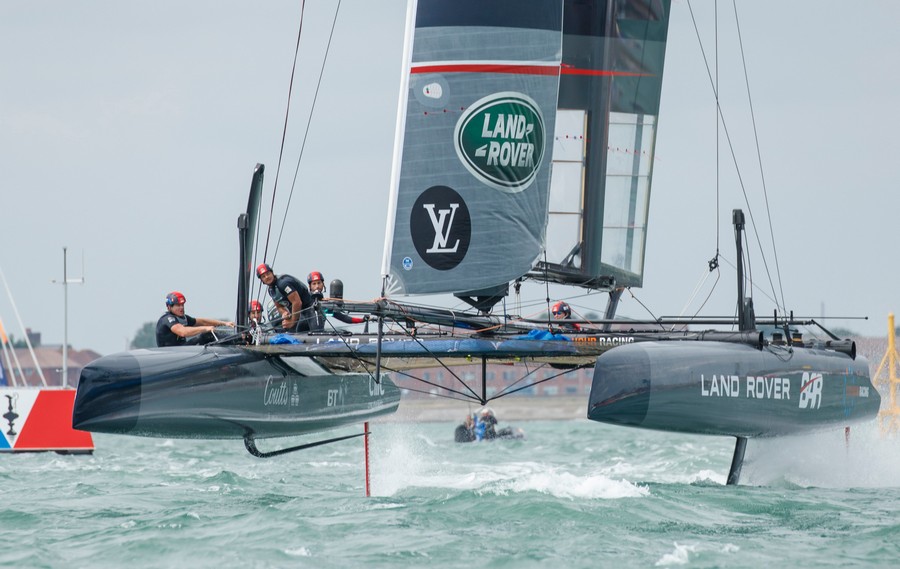
Emirates Team New Zealand, rejuvenated behind the leadership of Grant Dalton, won the Louis Vuitton Cup to set up a rematch against Alinghi. But although the Kiwis won a couple of races and lost another by just one second, the Swiss Defender proved to be too strong and retained the title.
Multihull Battle
Shortly after successfully defending the Cup, SNG announced it had accepted a challenge from a newly formed yacht club, the Spanish CNEV, and released a Protocol for the 33rd America’s Cup.
Many in the America’s Cup community balked at the terms in the Protocol and BMW ORACLE Racing, with Larry Ellison leading the charge, challenged the validity of the new Spanish club. The courts agreed and GGYC became the challenger of record. When GGYC and SNG were unable to mutually consent on a new Protocol, the 33rd America’s Cup became a ‘Deed of Gift’ Match, as in 1988.
There were numerous court challenges, initiated by both sides. In the end, both teams having learned the lesson of 1988, built enormous multihulls. Then, just months before the race, BMW ORACLE Racing replaced its soft sail rig with a towering wing sail – the largest wing ever built.
When the boats finally lined up to race off Valencia in February 2010, the BMW ORACLE Racing trimaran with its powerful wing sail proved to be superior. Skipper James Spithill, just 30 years old, won with a record of 2-0. Once again, the America’s Cup would be defended by an American Team in the 34th edition.
Battle on the Bay
The speed, the thrill and the challenge of building multihulls proved irresistible and ORACLE TEAM USA elected to make the AC72, a catamaran powered by a towering wingsail, the class for the 34th America’s Cup. The venue would be the iconic San Francisco Bay, where late summer winds were predictable and strong.
Emirates Team New Zealand was among three challengers (along with Artemis Racing and Luna Rossa Challenge) lined up to battle ORACLE TEAM USA.
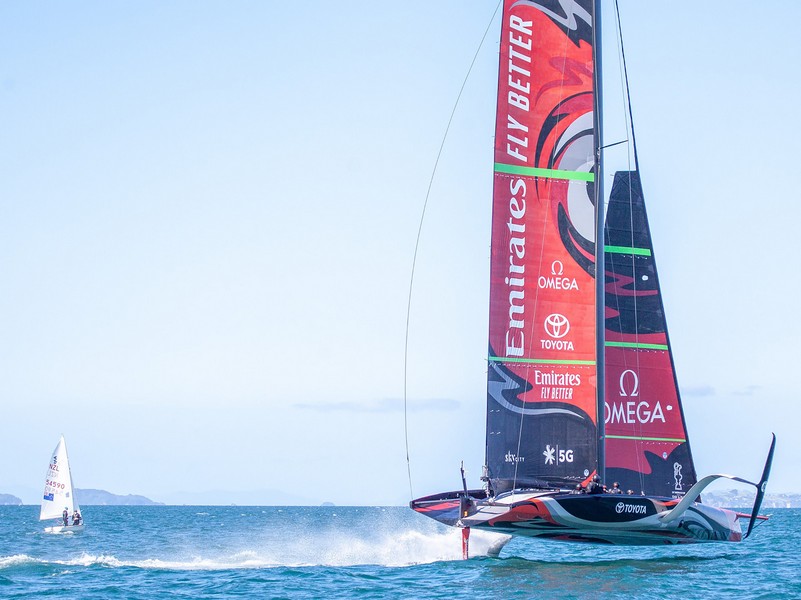
The Kiwis, always pushing the boundaries of innovation were the first team to bring foiling to the America’s Cup enabling the AC72 to get up and out of the water, foiling, and soon all the teams were flying above the water at speeds over 40 knots.
Emirates Team New Zealand’s ingenuity would revolutionize the modern America’s Cup to a high speed and action packed event focused on a younger and athletic generation of sailors.
The boats were without risk however, and ORACLE TEAM USA capsized during training on San Francisco Bay, all but destroying one of their boats and setting their program back by months.
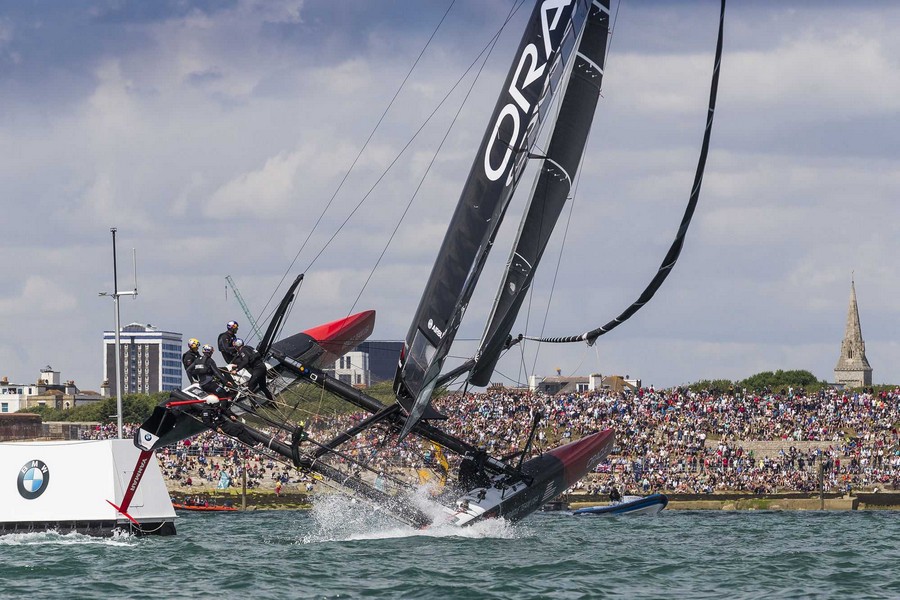
Tragically, Artemis Racing also had a training accident and crew member Andrew ‘Bart’ Simpson perished when he became trapped under the capsized boat. His memory lives on through the Andrew Simpson Sailing Foundation, a charity devoted to youth sailing projects.
With new safety regulations developed following the accident, racing started in the challenger series, where Emirates Team New Zealand made short work of Artemis Racing and Luna Rossa Challenge.
The Kiwis then jumped out to an impressive lead in the America’s Cup Match over ORACLE TEAM USA, who couldn’t match the New Zealander’s upwind speed.
After making a critical crew change, bringing on Ben Ainslie for John Kostecki, and making continual modifications to their boat and sailing techniques, the Americans were getting faster, but were running out of time. Emirates Team New Zealand reached match point, building an 8-1 lead.
But improbably, ORACLE TEAM USA turned the tide and began to win races. The gap narrowed and then disappeared. Now it was ORACLE TEAM USA who were faster and the score was tied, 8-8. There would be one last race; the winner would claim the Cup.
The final race was a microcosm of the match itself. Emirates Team New Zealand had an early lead, but couldn’t fend off the American boat. ORACLE TEAM USA sailed into history, taking the closest match in America’s Cup history, 9-8.
The Battle Of Bermuda
Oracle Team USA decided to take the event out of their home country to the pristine island of Bermuda for the 35th edition.
After a torrid few years following the brutal defeat in San Francisco, Emirates Team New Zealand quietly rebuilt a refreshed young and hungry team Skippered by Glenn Ashby and helmed by Olympic Gold Medalist Peter Burling.
Developing their campaign in silo in their home base of Auckland, New Zealand while most other challengers and the defenders Oracle Team USA set up camp in Bermuda, the kiwis continued to innovate and push the boundaries in secrecy by “Throwing the ball as far as possible in terms of design and innovation to see if they could reach it.”
They surprised the sailing and America’s Cup world just a few months before the start of the event, by launching a revolutionary boat with ‘cyclors’ powering their AC50 catamaran.
Their boat concept was so far advanced there was no time for the innovation to be replicated this time, despite futile attempts by the Oracle Team USA.
Emirates Team New Zealand, won all of their double round robin races except their two races against the defender Oracle team USA who were racing in the Challenger Selection Series for the first time in history providing the American team with a false sense of hope.
The hardened kiwis came back from a near catastrophic capsize to beat Land Rover BAR in the semi finals and then the Swedish team Artemis Racing in the Louis Vuitton Cup Final, providing the ticket for a heavy weight rematch against Oracle Team USA, who went into the match with a 1 point lead.
Emirates Team New Zealand’s push for redemption was swift, a dominant display blew Oracle Team USA away 7-1 to win the America’s Cup for the third time.
The Return to Auckland
The jubilant and proud Kiwis took the America’s Cup back to Auckland where preparations and a Protocol was promptly developed, together with Challenger of Record – Luna Rossa, for the 36th America’s Cup in their home waters.

An exciting new class of boat, the AC75, a foiling monohull, the likes of which had never been seen before was announced along with the title event sponsor PRADA, setting the foundations of an exciting event in 2021.


